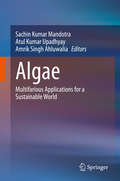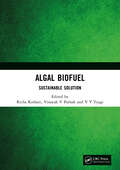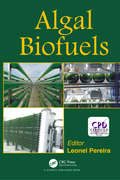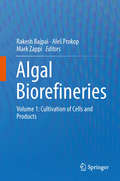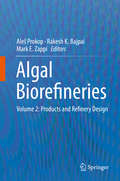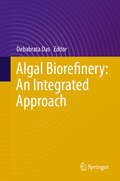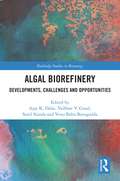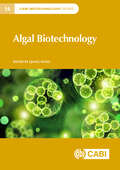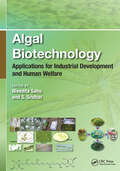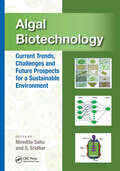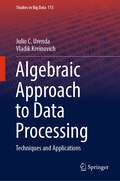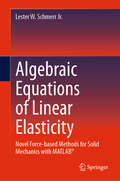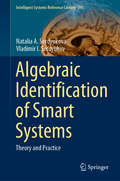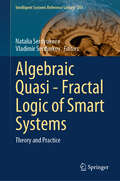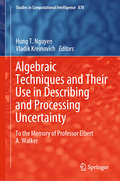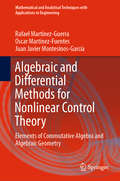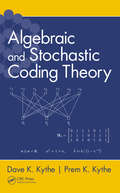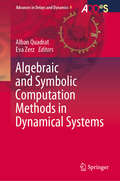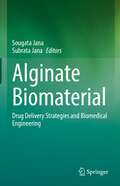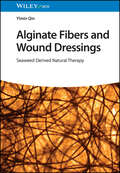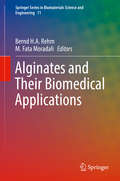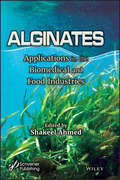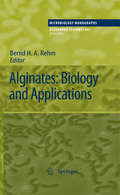- Table View
- List View
Algae: Multifarious Applications for a Sustainable World
by Atul Kumar Upadhyay Sachin Kumar Mandotra Amrik Singh AhluwaliaThis exciting book presents diverse applications of microalgal renewable resources to meet modern demands for energy and value-added products. It also comprehensively describes the role of algae in sustainable and cost-effective wastewater treatment strategies, and highlights the latest research on, advances in and biotechnological relevance of algae in the areas of bioenergy, bioremediation, pharmaceuticals, nutraceuticals and green economy. The book addresses gaps in the fields of bioenergy, waste management, health and economy by providing broad information on bioenergy production, management strategies, drug development, nutraceuticals products and biobased economy using algae at the commercial level. The book introduces researchers to key and emerging innovations in the field of algal biology research and will assist policymakers, environmentalists, scientists, students and global thinkers in defining sustainable developmental goals for the future. Accordingly, it is an extremely important read for researchers and students in the environmental sciences, life sciences and chemistry, experts in the energy sector and policymakers alike.
Algal Biofuel: Sustainable Solution
by Richa Kothari V. V. Tyagi Vinayak V. PathakAlgal Biofuel: Sustainable Solution primarily focuses on the different aspects of bioenergy production using algal biomass as microalgae are considered the optimum feedstock for bioenergy production. The major aim is to thoroughly review the available bioenergy options, challenges in bioenergy production, availability of bioenergy feedstock, and biomass to bioenergy conversion process. This book also highlights the feasibility of lignocellulosic biomass, crop residues, and non-edible oil seeds for generation of different bioenergy products. It will be helpful for researchers and other stakeholders working in the area of bioenergy production for development of innovative concepts in emerging areas of bioenergy. Print edition not for sale in South Asia (India, Sri Lanka, Nepal, Bangladesh, Pakistan and Bhutan).
Algal Biofuels
by Leonel PereiraAlgae presents a viable biofuel alternative because the production of algae for fuel, unlike other agro-based biofuels, does not compete with food production. This book covers algae-based biofuel options and discusses the design and economic viability of algal bioenergy co-production concepts.
Algal Biofuels: Recent Advances and Future Prospects
by Faizal Bux Sanjay Kumar Gupta Anushree MalikThis edited volume focuses on comprehensive state-of-the-art information about the practical aspects of cultivation, harvesting, biomass processing and biofuel production from algae. Chapters cover topics such as synthetic ecological engineering approaches towards sustainable production of biofuel feedstock, and algal biofuel production processes using wastewater. Readers will also discover more about the role of biotechnological engineering in improving ecophysiology, biomass and lipid yields. Particular attention is given to opportunities of commercialization of algal biofuels that provides a realistic assessment of various techno-economical aspects of pilot scale algal biofuel production. The authors also explore the pre-treatment of biomass, catalytic conversion of algal lipids and hydrothermal liquefaction with the biorefinery approach in detail. In a nut shell, this volume will provide a wealth of information based on a realistic evaluation of contemporary developments in algal biofuel research with an emphasis on pilot scale studies. Researchers studying and working in the areas of environmental science, biotechnology, genetic engineering and biochemistry will find this work instructive and informative.
Algal Biorefineries: Volume 1: Cultivation of Cells and Products
by Aleš Prokop Rakesh Bajpai Mark ZappiThis book reviews efforts to produce chemicals and fuels from forest and plant products, agricultural residues and more. Algae can potentially capture solar energy and atmospheric CO2; the book details needed research and legislative initiatives.
Algal Biorefineries: Volume 2: Products and Refinery Design
by Aleš Prokop Rakesh K. Bajpai Mark E. ZappiAlgae offer potential to produce renewable chemicals and fuels using solar energy and carbon dioxide from atmosphere or in flue gases while simultaneously reducing the generation of greenhouse gases. Since these can be grown on marginal lands with micronutrients and macronutrients often present in waste streams, algae-based chemicals and fuels do not compete with foods. Still large-scale production of algae-based fuels and chemicals faces considerable technological and economical challenges and it would by necessity require a biorefinery approach wherein all the possible algal components are converted into value-added compounds. The present series on algal biorefineries represents a forum for reporting the state of the art of different technologies as well as the latest advances in this field. The volume II of this series complements the volume I in terms of the current state of the art. Different chapters in this volume address diverse issues ranging from genetically modifies algae to new products to life-cycle analysis of algal products.
Algal Biorefinery: An Integrated Approach
by Debabrata DasThis book critically discusses different aspects of algal production systems and several of the drawbacks related to microalgal biomass production, namely, low biomass yield, and energy-consuming harvesting, dewatering, drying and extraction processes. These provide a background to the state-of-the-art technologies for algal cultivation, CO2 sequestration, and large-scale application of these systems. In order to tap the commercial potential of algae, a biorefinery concept has been proposed that could help to extract maximum benefits from algal biomass. This refinery concept promotes the harvesting of multiple products from the feedstock so as to make the process economically attractive. For the last few decades, algal biomass has been explored for use in various products such as fuel, agricultural crops, pigments and pharmaceuticals, as well as in bioremediation. To meet the huge demand, there has been a focus on large-scale production of algal biomass in closed or open photobioreactors. Different nutritional conditions for algal growth have been explored, such as photoautotrophic, heterotrophic, mixotrophic and oleaginous. This book is aimed at a wide audience, including undergraduates, postgraduates, academics, energy researchers, scientists in industry, energy specialists, policy makers and others who wish to understand algal biorefineries and also keep abreast of the latest developments.
Algal Biorefinery: Developments, Challenges and Opportunities (Routledge Studies in Bioenergy)
by Sonil Nanda Ajay K. Dalai Vaibhav V. Goud Venu Babu BorugaddaThis book enables readers to understand the theoretical aspects, key steps and scientific techniques with a detailed mechanism to produce biofuels from algae. Each chapter provides the latest developments and recent advancements starting from algal cultivation techniques to the production of value-added green fuels, chemicals and products with wide applications. The volume brings together a broad range of international and interdisciplinary experts, including chemical and biological engineers, biotechnologists, process engineers, environmentalists, pharmacists and nutritionists, to one platform to explore the beneficial aspects and challenges for an algal-based biorefinery. Chapters address cutting-edge issues surrounding algal cultivation, including genetic modification of algal strains, design and optimization of photobioreactors and open-pond systems, algal oil extraction techniques and algal-derived fuel products (biodiesel, bio-gasoline, jet fuels and bio-oil). Finally, the book considers the potential environmental impacts for establishing a sustainable algal biorefinery through lifecycle analysis, techno-economic assessment and supply chain management. This book will be an important resource for students, academics and professionals interested in algal cultivation, biofuels and agricultural engineering, and renewable energy and sustainable development more broadly.
Algal Biotechnology (CABI Biotechnology Series)
by Sanjay Gupta Jin Wang Vinod Kumar Xu Zhang Lei Chen Chao Li Weiwen Zhang Xinyu Song Xiaojun Yan Chengxu Zhou Roger Ruan Yahui Bo Gao Chen Zhenfan Chen Zixi Chen Pengfei Cheng Feng Ge Jiameng Guo Xiahui Hao Qingfang He Fan Hu Hanhua Hu Krishna Kumar Jaiswal Hu Jin Anping Lei Anna I. Kurbatova Yanhua Li Hanzhi Lin Lu-Ning Liu Qiong Liu Yandu Lu Anastasios Melis Yufang Pan Vishal Rajput Shengzhou Shan Kaitlin Simmons Xiaotong Song Adamu Yunusa Ugya Mikhail S. Vlaskin Chun Wang Jiangxin Wang Wenxiu Yin Xiangxiang Zhang Yu-Zhong Zhang Long-Sheng Zhao Quanyu Zhao Yali Zhu Zhu Zhen Tian Jing Cao XupengAlgae are sunlight-driven cell factories, and can efficiently absorb CO2 and convert light energy to chemical energy such as lipid, starch and other carbohydrates and release O2. Algal feedstock is a promising resource for bioproduct production, given its high photosynthetic efficiency for producing biomass compared to conventional crops. Microalgae can be used for flue-gas and wastewater bioremediation. This book highlights recent breakthroughs in the multidisciplinary areas of algal biotechnology and the chapters feature recent developments from cyanobacteria to eukaryotic algae, from theoretical biology to applied biology. It also includes the latest advancements in algal-based synthetic biology, including metabolic engineering, artificial biological system construction and green chemicals production. With contributions by leading authorities in algal biotechnology research, it is a valuable resource for graduate students and researchers in the field, and those involved in the study of photosynthesis and green-cell factories.
Algal Biotechnology: Applications for Industrial Development and Human Welfare
by S. Sridhar Nivedita SahuThis book deals with an interdisciplinary approach towards present-day practical challenges and recent developments in algal biotechnology and covers a broad spectrum of issues ranging from diverse algae and its applications in agriculture, human food, animal feed, wastewater treatment, and industry to algal metabolites. Major themes covered in this volume include algae-based processes for the treatment of industrial effluents, algal biorefinery, industrial trends, and applications of algae in food, feed, nutraceuticals, and pharmaceuticals.Features: Explores the possibility of utilization of algae in human food and pharmaceutical compounds. Presents recent state of the art of design and tools in algal biorefineries. Reviews concepts of membrane bioreactors and microbial fuel cells, including their process and performance. Algae-based technologies for safe and eco-friendly processes to promote a sustainable bio-economy. Discusses algae as a source for potential aquafeed. This book is aimed at graduate students and researchers in biotechnology, bioenergy , renewable energy, energy, fuel and petrochemicals, wastewater, novel technologies, clean technologies, bioremediation environmental biotechnology, functional foods and nutraceuticals, and marine and aquatic science.
Algal Biotechnology: Current Trends, Challenges and Future Prospects for a Sustainable Environment
by S. Sridhar Nivedita SahuThis book initiates with a general introduction to microalgae and algal biotechnology with subsequent discussions on all the significant aspects of applied biotechnology, bioremediation, nano applications, multidimensional usages of algae as a biofertilizer, and a source of bioactive compounds and phytochemicals. Major themes of the book include algae and the environment, bioremediation using algae, algal-omics and applications, and large-scale bioprocesses for algal cultivation, its constraints and challenges.Features: Focusses on the importance of algae for a sustainable environment Covers algal bioplastics and other commercial products Explores possible utilization of algae in phyco/bioremediation Reviews algae as a biostimulant and biofertilizer Demonstrates challenges during algal cultivation on a large scale This book is aimed at graduate students and researchers in biotechnology, bioenergy, renewable energy, energy, bioremediation, fuel and petrochemicals, wastewater, novel technologies, clean technologies, bioremediation environmental, functional foods and nutraceuticals, marine and aquatic science.
Algebraic Approach to Data Processing: Techniques and Applications (Studies in Big Data #115)
by Vladik Kreinovich Julio C. UrendaThe book explores a new general approach to selecting—and designing—data processing techniques. Symmetry and invariance ideas behind this algebraic approach have been successful in physics, where many new theories are formulated in symmetry terms. The book explains this approach and expands it to new application areas ranging from engineering, medicine, education to social sciences. In many cases, this approach leads to optimal techniques and optimal solutions. That the same data processing techniques help us better analyze wooden structures, lung dysfunctions, and deep learning algorithms is a good indication that these techniques can be used in many other applications as well. The book is recommended to researchers and practitioners who need to select a data processing technique—or who want to design a new technique when the existing techniques do not work. It is also recommended to students who want to learn the state-of-the-art data processing.
Algebraic Codes for Data Transmission
by Richard E. BlahutThe need to transmit and store massive amounts of data reliably and without error is a vital part of modern communications systems. Error-correcting codes play a fundamental role in minimising data corruption caused by defects such as noise, interference, crosstalk and packet loss. This book provides an accessible introduction to the basic elements of algebraic codes, and discusses their use in a variety of applications. The author describes a range of important coding techniques, including Reed-Solomon codes, BCH codes, trellis codes, and turbocodes. Throughout the book, mathematical theory is illustrated by reference to many practical examples. The book was first published in 2003 and is aimed at graduate students of electrical and computer engineering, and at practising engineers whose work involves communications or signal processing.
Algebraic Equations of Linear Elasticity: Novel Force-based Methods for Solid Mechanics with MATLAB®
by Lester W. Schmerr Jr.This book describes a second-generation force-based method emerging from a general formulation where the partial differential equations of elasticity are replaced by equivalent algebraic equations. These algebraic equations of linear elasticity can be used to solve statically indeterminate problems in reduced forms that define either the new second-generation force-based approach or a new displacement-based approach. The new force-based method can serve as the basis for teaching students at many technical levels how to solve equilibrium problems directly for the forces present. In elasticity courses, the derivation and use of the algebraic equations of linear elasticity can show how the difficulties of dealing with partial differential equations may be avoided by transforming those equations into algebraic equations with work-energy concepts. In a finite element course, a force-based finite element method can be described along with the traditional displacement-based approach to demonstrate how the two methods provide alternative ways for solving complex structural problems. Serving as a resource for including second-generation force-based methods in solid mechanics courses of an engineering curriculum, and as a robust learning resource, the book is ideal for instructors and for students, practicing engineers, and researchers.
Algebraic Identification of Smart Systems: Theory аnd Practice (Intelligent Systems Reference Library #191)
by Natalia A. Serdyukova Vladimir I. SerdyukovThis book is a continuation of our recently published book “Algebraic formalization of smart systems. Theory and practice.” It incorporates a new concept of quasi-fractal algebraic systems, based on A.I. Maltsev’s theory of algebraic systems and the theory of fractals developed by Benoit Mandelbrot, to investigate smart systems in more detail. The main tool used in the book, quasi-fractal algebraic systems, helps us to see smart systems in more detail by adding new factors, which e.g. make it possible to describe the previously indivisible elements of the initial model of factors. The techniques presented include fixed-point theorem, theorems of group theory, theory of Boolean algebras, and Erdös-Renyi algorithms. Given its focus, the book is intended for anyone interested in smart system theory.
Algebraic Quasi—Fractal Logic of Smart Systems: Theory and Practice (Intelligent Systems Reference Library #251)
by Natalia Serdyukova Vladimir SerdyukovThis book is a continuation of the Algebraic Formalization of Smart Systems. Theory and Practice, 2018, and Algebraic Identification of Smart Systems. Theory and Practice, 2021. Algebraic logic refers to the connection between Boolean algebra and classical propositional calculus. This connection was discovered by George Boole and then developed by other mathematicians, such as C. S. Peirce and Ernst Schroeder. This trend culminated in the Lindenbaum-Tarski algebras. Here we try to connect algebraic logic and quasi-fractal technique, based on algebraic formalization of smart systems to get facts about smart systems functioning and connections of their qualitative and quantitative indicators. Basic techniques we used: algebraic quasi-fractal systems, Erdős–Rényi algorithm, a notion of –giant component of an algebraic system, fixed point theorem, purities, i.e., embeddings preserving -property of an algebraic system. The book is aimed for all interested in these issues.
Algebraic Techniques and Their Use in Describing and Processing Uncertainty: To the Memory of Professor Elbert A. Walker (Studies in Computational Intelligence #878)
by Vladik Kreinovich Hung T. NguyenThis book discusses heuristic methods – methods lacking a solid theoretical justification – which are ubiquitous in numerous application areas, and explains techniques that can make heuristic methods more reliable. Focusing on algebraic techniques, i.e., those that use only a few specific features of a situation, it describes various state-of-the-art applications, ranging from fuzzy methods for dealing with imprecision to general optimization methods and quantum-based methods for analyzing economic phenomena. The book also includes recent results from leading researchers, which could (and hopefully will) provide the basis for future applications. As such, it is a valuable resource for mathematicians interested in potential applications of their algebraic results and ideas, as well as for application specialists wanting to discover how algebraic techniques can help in their domains.
Algebraic and Differential Methods for Nonlinear Control Theory: Elements of Commutative Algebra and Algebraic Geometry (Mathematical and Analytical Techniques with Applications to Engineering)
by Rafael Martínez-Guerra Oscar Martínez-Fuentes Juan Javier Montesinos-GarcíaThis book is a short primer in engineering mathematics with a view on applications in nonlinear control theory. In particular, it introduces some elementary concepts of commutative algebra and algebraic geometry which offer a set of tools quite different from the traditional approaches to the subject matter. This text begins with the study of elementary set and map theory. Chapters 2 and 3 on group theory and rings, respectively, are included because of their important relation to linear algebra, the group of invertible linear maps (or matrices) and the ring of linear maps of a vector space. Homomorphisms and Ideals are dealt with as well at this stage. Chapter 4 is devoted to the theory of matrices and systems of linear equations. Chapter 5 gives some information on permutations, determinants and the inverse of a matrix. Chapter 6 tackles vector spaces over a field, Chapter 7 treats linear maps resp. linear transformations, and in addition the application in linear control theory of some abstract theorems such as the concept of a kernel, the image and dimension of vector spaces are illustrated. Chapter 8 considers the diagonalization of a matrix and their canonical forms. Chapter 9 provides a brief introduction to elementary methods for solving differential equations and, finally, in Chapter 10, nonlinear control theory is introduced from the point of view of differential algebra.
Algebraic and Stochastic Coding Theory
by Prem K. Kythe Dave K. KytheUsing a simple yet rigorous approach, Algebraic and Stochastic Coding Theory makes the subject of coding theory easy to understand for readers with a thorough knowledge of digital arithmetic, Boolean and modern algebra, and probability theory. It explains the underlying principles of coding theory and offers a clear, detailed description of each code. More advanced readers will appreciate its coverage of recent developments in coding theory and stochastic processes. After a brief review of coding history and Boolean algebra, the book introduces linear codes, including Hamming and Golay codes. It then examines codes based on the Galois field theory as well as their application in BCH and especially the Reed–Solomon codes that have been used for error correction of data transmissions in space missions. The major outlook in coding theory seems to be geared toward stochastic processes, and this book takes a bold step in this direction. As research focuses on error correction and recovery of erasures, the book discusses belief propagation and distributions. It examines the low-density parity-check and erasure codes that have opened up new approaches to improve wide-area network data transmission. It also describes modern codes, such as the Luby transform and Raptor codes, that are enabling new directions in high-speed transmission of very large data to multiple users. This robust, self-contained text fully explains coding problems, illustrating them with more than 200 examples. Combining theory and computational techniques, it will appeal not only to students but also to industry professionals, researchers, and academics in areas such as coding theory and signal and image processing.
Algebraic and Symbolic Computation Methods in Dynamical Systems (Advances in Delays and Dynamics #9)
by Alban Quadrat Eva ZerzThis book aims at reviewing recent progress in the direction of algebraic and symbolic computation methods for functional systems, e.g. ODE systems, differential time-delay equations, difference equations and integro-differential equations. In the nineties, modern algebraic theories were introduced in mathematical systems theory and in control theory. Combined with real algebraic geometry, which was previously introduced in control theory, the past years have seen a flourishing development of algebraic methods in control theory. One of the strengths of algebraic methods lies in their close connections to computations. The use of the above-mentioned algebraic theories in control theory has been an important source of motivation to develop effective versions of these theories (when possible). With the development of computer algebra and computer algebra systems, symbolic methods for control theory have been developed over the past years. The goal of this book is to propose a partial state of the art in this direction. To make recent results more easily accessible to a large audience, the chapters include materials which survey the main mathematical methods and results and which are illustrated with explicit examples.
Alginate Biomaterial: Drug Delivery Strategies and Biomedical Engineering
by Sougata Jana Subrata JanaThis book focuses on recent trends of research on alginate-based biomaterials in Drug Delivery strategies and biomedical engineering. It contains the widely used alginate-based biomaterials as micro to nano-controlled drug delivery (oral, ocular delivery, topical delivery, etc.) and its fabrication technology, characterization, and biomedical aspects (such as cancer therapy, tissue engineering, gene delivery, vaccine delivery, enzyme immobilization, wound healing, dental applications, etc.) in a single book. The chapters cover updated information, current research trends, informatics, and all aspects of applications. Alginate is a U.S. Food and Drug Administration (FDA)-approved natural biomaterial and has diverse biomedical applications. In recent years, researchers and scientists are working on the alginate-based drug delivery systems that have been designed and characterized as a matrix, micro to nanocarriers, fibers, composite/scaffolds, etc. Alginate has versatile properties such as biodegradable, biocompatible, nontoxic, and easily available. This book especially highlights both the drug delivery strategies and biomedical engineering aspects such as controlled drug delivery, drug targeting to the site of action, cancer therapy, gene and vaccine delivery, enzyme immobilization, tissue engineering, and regenerative medicine.
Alginate Fibers and Wound Dressings: Seaweed Derived Natural Therapy
by Yimin QinAlginate Fibers and Wound Dressings Comprehensive resource on the science and research behind alginate fibers, along with their many functional applications in different fields Alginate Fibers and Wound Dressings: Seaweed Derived Natural Therapy offers a general introduction to the sources of alginate and the production methods for alginate fibers and wound dressings, in addition to the novel properties and applications of these functional materials in wound management. Taking into consideration of the latest results of clinical researches conducted around the world, this book summarizes the unique properties of alginate wound dressings, including their ‘gel blocking’ properties and the ability to promote wound healing, facilitate haemostasis, reduce pain, suppress bacteria growth, and lower treatment cost in the treatment of a wide range of wounds, including leg ulcers, burn wounds, pressure sores, surgical wounds, and many other types of wounds with high levels of exudates. Sample topics covered in Alginate Fibers and Wound Dressings include: Why alginate fibers can be used as a carrier to deliver zinc, copper, silver, and other bioactive metal ions How alginate wound dressings can help maintain a physiologically moist microenvironment that promotes healing and the formation of granulation tissue Unique properties of alginate fibers that are highly useful for functional textile materials and medical textile products, such as gel forming properties when in contact with body fluid Other excellent performance characteristics of alginate fibers, such as haemostatic, antimicrobial, skin whitening, and many other unique bioactivities Providing comprehensive coverage of the subject, Alginate Fibers and Wound Dressings is an essential resource for students, researchers, and professionals involved in professions and programs of study that intersect with the subject.
Alginates and Their Biomedical Applications (Springer Series in Biomaterials Science and Engineering #11)
by Bernd H.A. Rehm M. Fata MoradaliThis book presents a comprehensive review of the latest advances in developing alginate-based biomaterials and derivatives as well as their biomedical and pharmaceutical applications. It covers the physiochemical properties of alginates, production and formulation methods, derivatizations and characterization methods, the fundamental work on optimizing alginate polymers for defined biomedical purposes as well as the scope and effectiveness of their applications in medicine and therapeutic approaches. The book brings together new concepts and advances in harnessing alginate-based biomaterials in combination with applied technological advances to tailor their applications to medical needs. The contributions by leading academics, clinicians and researchers not only cover the fundamentals, but also open new avenues for meeting future challenges in research and clinical applications.
Alginates: Applications in the Biomedical and Food Industries
by Shakeel AhmedAlginate is a hydrophilic, biocompatible, biodegradable, and relatively economical polymer generally found in marine brown algae. The modification in the alginate molecule after polymerization has shown strong potential in biomedical, pharmaceutical and biotechnology applications such as wound dressing, drug delivery, dental treatment, in cell culture and tissue engineering. Besides this, alginates have industrial applications too in the paper and food industries as plasticizers and additives. The few books that have been published on alginates focus more on their biology. This current book focuses on the exploration of alginates and their modification, characterization, derivatives, composites, hydrogels as well as the new and emerging applications.
Alginates: Biology And Applications (Microbiology Monographs #13)
by Bernd H. Rehm"Alginates: Biology and Applications" provides an overview of the state of art of alginate material properties, genetics and the molecular mechanisms underlying alginate biosynthesis as well as applications of tailor-made alginates in medicine, food and biotechnology. Topics treated are: material properties of alginates, alginate production: precursor biosynthesis, polymerization and secretion, bacterial system for alginate uptake and degradation, enzymatic alginate modification, alginate gene regulation, role of alginate in bacterial biofilms, microbial production of alginates: physiology and process aspects, alginate-based blends and nano/microbeads, applications of alginates in food, alginate and its comonomer mannuronic acid: medical relevance as drugs.
